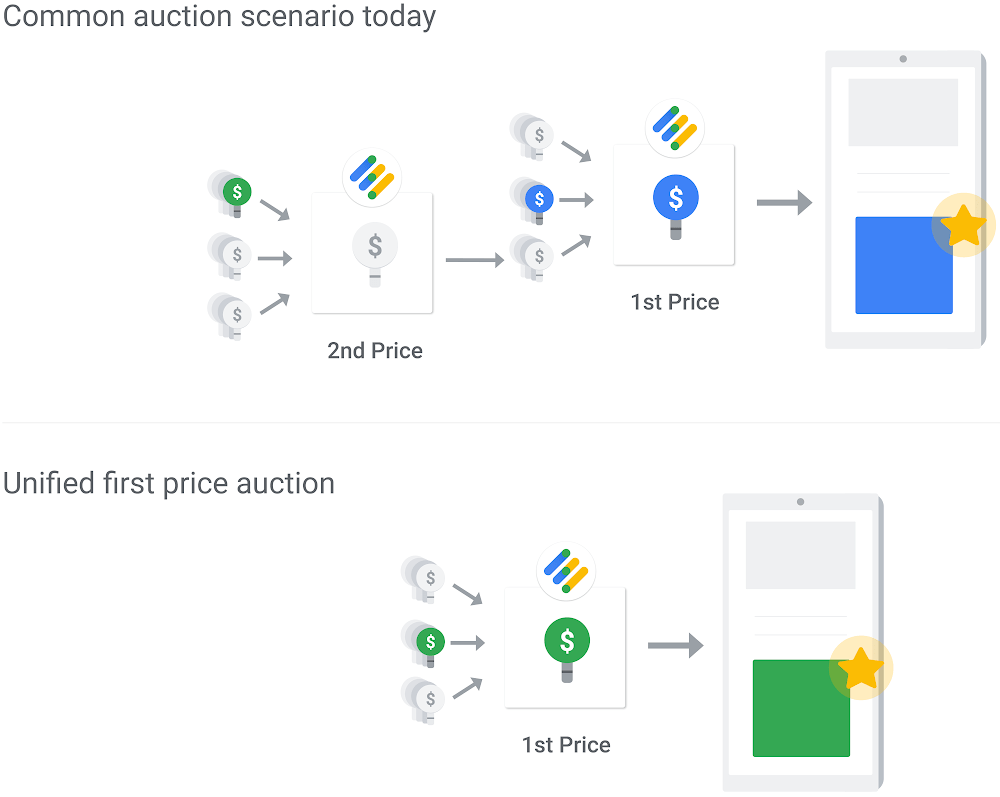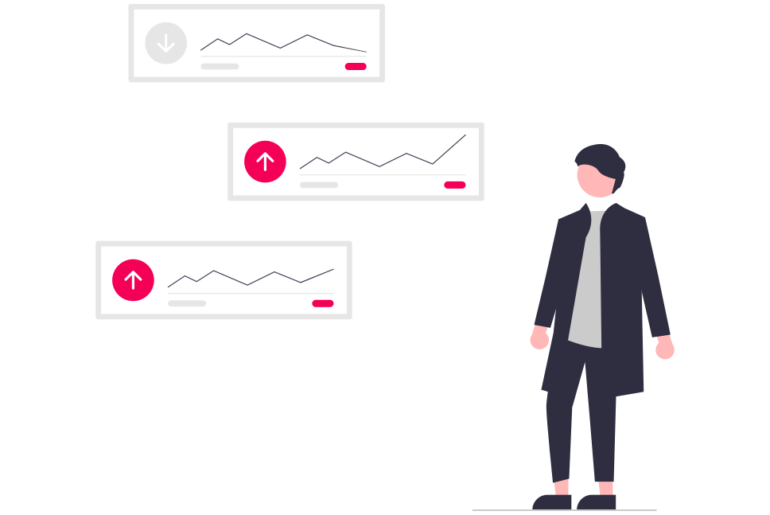Google ads manager pricing comes in different models. What you pay varies somewhat depending on how you have set the pricing.
In 2019, Google ad manager saw a shift to a newer pricing model called, Unified Pricing. If you have been keeping up with the Adtech industry lately, you may be aware of the industry’s size and abundance of things to discover; Unified Pricing is just one of the Adtech operations.
This new model has helped simplify how ads are priced and managed within the Google ecosystem, making it easier for Ad Manager users to get the most out of their campaigns.
Unified pricing is part of the Ad Manager’s transition to the first-price auction. With the second-price auction model shifting to first-price, advertisers and DSPs will try to indulge in bid shading — they will try and lower their bids. And Unified Pricing is supposed to tackle this by running a unified auction.
Before we delve deeper into the unified pricing rules, let’s first understand Google Ad manager pricing rules.
Types of Google Ad Manager Pricing Rules
There are two types of Google ad manager pricing rules: standard and unified. Standard pricing rules are the older type of pricing rules, while unified pricing rules are the newer, more flexible type.
With standard pricing rules, you can set different prices for different ad groups or campaigns. This can be helpful if you want to optimize your campaigns for different goals. For example, you could set a higher price for a campaign focused on sales and a lower price for a campaign focused on brand awareness.
With unified pricing rules, you can set one price for all your ad groups and campaigns. This can be helpful if you want to simplify your pricing structure or if you want to make sure that all of your campaigns are priced equally.

Price floors were introduced to make sure that publishers would not accept bids under a certain CPM. If the bid offered by the advertiser was $2 and the price floor was set to $5, the advertiser would not have been able to win the impression.
However, high price floors are generally accompanied by a decrease in fill rate. Also, multiple instances (and filters) are applied to adjust to different advertisers, geographies—making price floors complex to manage.
Google believes that the move to first-price auctions is a necessary adjustment to better respond to a digital ad ecosystem, which is increasingly shifting towards first-price auctions and a model where consistent pricing rules will govern all demand sources. And overall, unified pricing is important to make ad tech less complex than what it is, right now.
What are Unified Pricing Rules?
Google Ad Manager’s Unified Pricing Rules feature allows publishers to manage floor prices and target CPM. This makes it easier for publishers to control their prices and reach their desired CPM goals while still taking advantage of all the available programmatic demand.
Unlike before, the pricing of all inventory across all indirect demand sources can now be controlled via Unified Pricing Rules under a single panel within the Google Ad Server. Basically, unified pricing is designed to work as a centralized floor price management system for all publisher’s inventory on Google Ad Manager.
Consistent rules and pricing will now be applied across all channels — Open Auction, Private Auction, and First Look Auction.
This is a list of channels that should experience the change:
- Open Bidding (Formerly Exchange Bidding)
- AdX Open Auction
- Private Auctions
- First Look Pricing
- Price Priority, Network, and Bulk line item types
As a publisher, if you have any of your website inventory transacted under any of the sources listed above, you will need to make a change to your pricing rules.
Steps to Configure Unified Pricing
You can set up a new Unified Pricing rule by following these steps:
- Login to Ad Manager account.
- Move to ‘Inventory’ tab
- Click the ‘Pricing Rules’ section
- Go to the ‘New Unified Pricing Rule’ button.
- Set all your rules at once.
Tackling Overlapping Rules
- Two rules targeting the same inventory: The one with the higher floor price applies
- Unified Pricing and Open Auction Rule applied to the same inventory: The one with the higher floor price applies
- Unified Pricing and First Look Pricing applied to the same inventory: The one with the higher floor price applies
New Limits to the Inventory
- Number Of Rules: 200 UPR’s per network.
- Type Settings: Only Target CPM and Fixed CPM can be set
- Scope of Rules: Advertiser / Buyer specific rules will now be applicable only for the AdX and EBDA traffic.
Advantages
- Operational simplicity: Instead of maintaining price floors in a fragmented manner, all price floors across all partners, can now be handled in one place
- Transparency and informed buyers: Another benefit of unified pricing rules is that it encourages transparency and keeps buyers informed. Given there will be constant floors across all partners and exchanges, buyers will be in a position to plan better and will know better what the publisher expects rather than trying workarounds like Bid Shading.
Drawbacks
- Rule limit: Only 200 UPR’s can be applied per network. This means that if you are a big publisher with millions and billions of pages, you will now be unable to make rules past this 200 mark.
- Per buyer limit: Setting per bidder floor prices will not be possible given the new changes. What that means is that the floor prices will remain the same for Google DBM and the other DSP’s like The Trade Desk. Some publishers who believed that Google leveraged its data capabilities are unhappy as they will now have to set the same floor prices as other (DSP’s) even to Adwords.
- Targeting/blocking limits: Only targeting advertisers and brands is possible now but not a buyer (like a network like AppNexus). Anonymous pricing has been dissolved and you can no longer possible to set priority rules anymore.
How to Exclude Inventory from Unified Pricing Rules?
- Click the Protections tab.
- Select New Protection > Inventory Exclusion
- Give a name for your protection
- Set targeting and inventory type to reflect the Open Auction pricing rule. Open Auction rule types are “Display”, “Mobile app”, “In-stream video”, and “Games”.
- Press “Save” for the rule to reflect in the Rules tab.
It seems like while empowering publishers, Google is also taking control of various programmatic and non-programmatic deals its hands by introducing a unified pricing system. For instance, SSP now won’t be able to add customized floor price to inventory sold via Ad Manager.
However, it’s just a matter of time before the publisher ecosystem comes up with new strategies and tactics to work with the new changes made to the Ad Manager.
Final Words
While empowering publishers, Google also controls various programmatic and non-programmatic deals by introducing a unified pricing system.
For instance, SSP now won’t be able to add customized floor prices to inventory sold via Ad Manager. However, it’s just a matter of time before the publisher ecosystem develops new strategies and tactics to work with the changes made to the Ad Manager.
We hope you found this post helpful and that you will take the time to review your own Google Ad Manager pricing rules, be it floor price or bidding amount. It will allow you to see if there are any changes that you can make to get the most value out of your marketing efforts.
Here are the some of the most commonly questions asked about Google ad manager pricing rules. Take a look
Frequently Asked Questions
If the publisher has not established pricing guidelines, the Google ad exchange will use the zero floor when conducting the first price auction.
Pricing unified rules can be helpful for both publishers and advertisers. Since advertisers generally have set-in-stone price points, they are likely to stick to them, especially while running media campaigns on a large scale.
Thus, publishers often find themselves in a situation where a given period of time sees two large advertisers with opposing price thresholds bidding for the exact same inventory. If unified pricing rules are in place, the prices for the same inventory will be automatically adjusted to meet the requirements of the advertiser offering the highest bid or the most lucrative offer.
As soon as you begin generating the rules under Unified Pricing regulations, they will be implemented. However, only 1% of the inventory will be eligible for First Price Auction. Other inventory will still be subject to Second Price Auction.

Shubham is a digital marketer with rich experience working in the advertisement technology industry. He has vast experience in the programmatic industry, driving business strategy and scaling functions including but not limited to growth and marketing, Operations, process optimization, and Sales.







